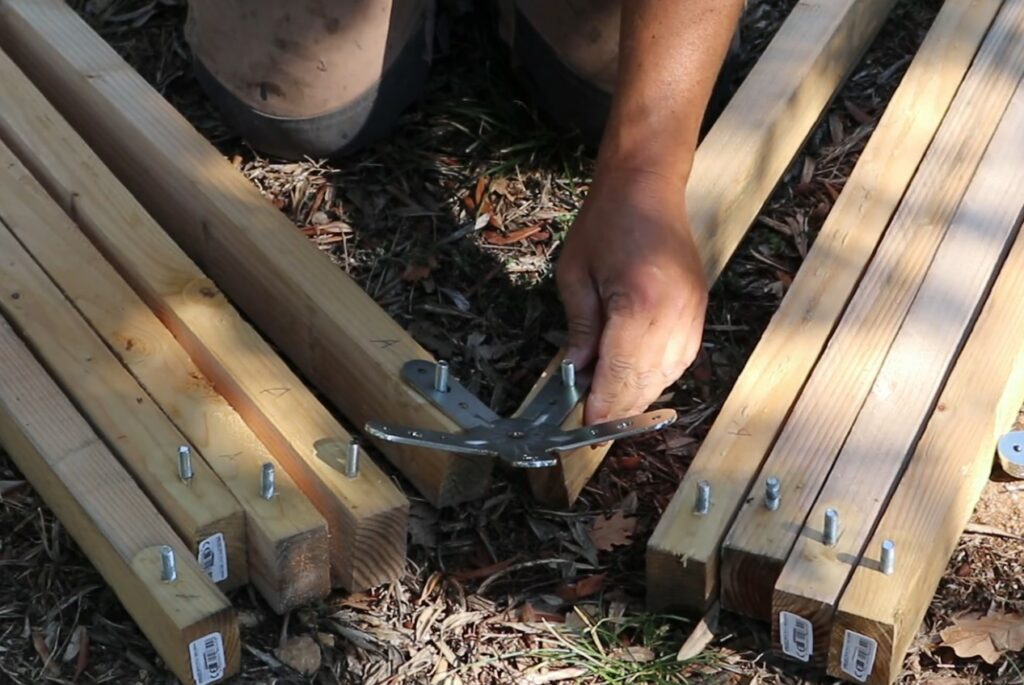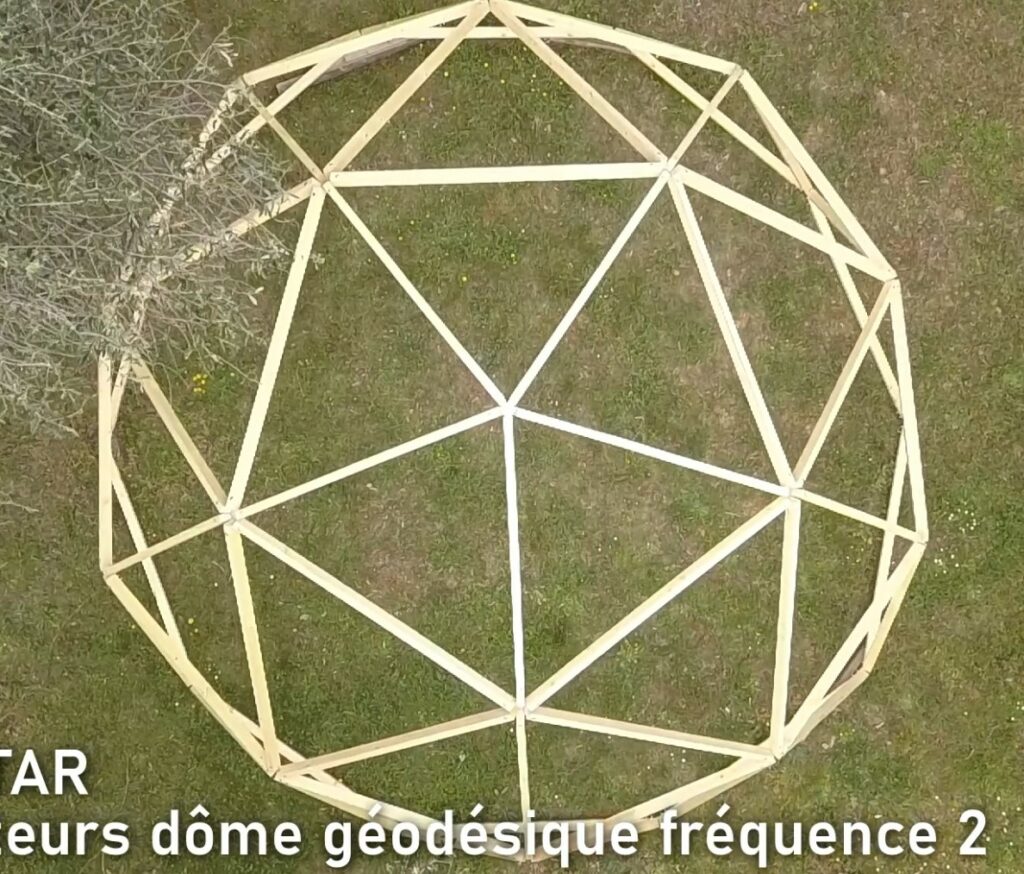Video Domestar 2-frequency Installation guide
Achetez Domestar en direct sur: / Purchase Domestar directly on: / Compre Domestar directamente en: / Acquista Domestar direttamente su: / Domestar direkt kaufen bei:
DOMESTAR Fréquence 1

Deutsch |
English |
Espanol |
Français |
Italiano
DOMESTAR Fréquence 2
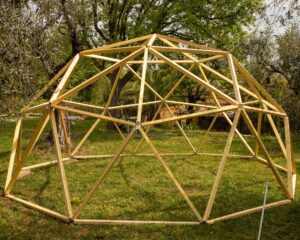
Deutsch |
English |
Espanol |
Français |
Italiano
DOMESTAR Fréquence 3 (3/8)

Deutsch |
English |
Espanol |
Français |
Italiano
DOMESTAR Fréquence 3 (5/8)
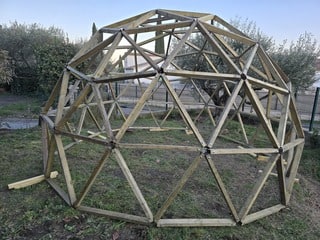
Deutsch |
English |
Espanol |
Français |
Italiano
DOMESTAR Fréquence 3 KRUSCHKE (3/8)

Deutsch |
English |
Espanol |
Français |
Italiano
DOMESTAR Fréquence 3 KRUSCHKE (5/8)

Deutsch |
English |
Espanol |
Français |
Italiano
DOMESTAR HEXDOME (5/8)
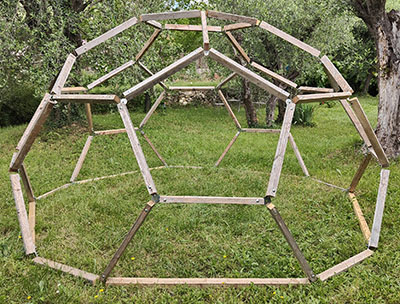
Deutsch |
English |
Espanol |
Français |
Italiano
Welcome to the assembly instructions for the geodesic dome using DOMESTAR Fréquence 2 connectors. If you have any questions, click on Contact to get in touch with me: I’ll be delighted to help you!
Save / Print this page as PDF:
Equipment required
- Set of 26 DOMESTAR 2-frequency connectors
- 65 wooden struts (joists) in 2 sizes (see size calculation table below)
- 130 bolts: screws and nuts. I strongly recommend countersunk square bolt (round head, square neck): one blow from a hammer and they’ll stay stuck in the wood and won’t turn when you tighten them
- (optional) 26 or 52 wood screws
The countersunk square bolt is also known as square neck bolt or cup square bolt.
Tools required
- tools for cutting the struts: ideally a radial saw, otherwise a circular saw or jigsaw
- a drill and a drill bit the thickness of the screws
- a spanner or ratchet to tighten the bolts, or an impact screwdriver (note: an impact screwdriver is NOT a percussion drill. With an impact screwdriver, you can screw or bolt much more strongly and quickly) or a simple screwdriver
- a hammer to drive in your countersunk square bolt.
- depending on the height of your geodesic dome bench or ladder
Size of your screws and bolts
The bolts must pass completely through the thickest side of the strut and the connector. I therefore advise you to choose a bolt length around 10 – 15 mm longer than the greatest thickness of your wood
FOR EXAMPLE, if your wood is 40x70mm, you’ll be drilling through 70mm. So use an 80mm or 90mm bolt
In terms of thickness, I recommend 8mm bolts (=M8)
I recommend using bolts rather than screws. The assembly is much more solid, as the bolts go through. But above all, dome assembly will be easier and can be done by one person using bolts
Choosing the size of your dome
Domestar 2V (=frequency 2) connectors allow you to mount a geodesic dome in “frequency 1” which uses only 2 different sizes / lengths of strut. You will need
- 30 small A-pillars
- 35 large B-pillars
The size of the struts will determine the size of the dome. Height, radius and diameter are therefore determined by the length of the struts
Here is a table showing the possible dome sizes according to the length of the A and B struts
Explanations
The geodesic dome I built had a radius of 2.67m (which I chose to optimise the cutting of my 3m joists). I therefore need to cut
- 30 A-pillars (small) measuring 1.399m
- 35 B-pillars (large) measuring 1.590m
NB: If you use another geodesic dome calculator, remember that these calculators often give you the measurements from “hole to hole”, i.e. the centre of the connector. However, there is 3 cm between the centre of the connector and the start of the connector leg. That’s why the 2 “hole to hole” columns are 6cm longer. But you need to cut to the length of the 2 columns A and B
What wood should I use for the geodesic dome struts?
I recommend using construction or decking timber that offers good strength at a fair price
The MINIMUM length and width of the struts should be 30mm to ensure the stability of the structure
Decking joists are very attractive, with dimensions of around 62x38mm or 70x45mm. The joists are also often treated to class 3 or class 4, giving this wood very good resistance to rain
Construction rafters / half-rafters (on the websites of major building retailers, type in “construction timber”) are often even cheaper and thicker with dimensions of 75×50, but their treatment and rain resistance is often inferior (generally class 2 – this is yellow-coloured wood)
TIP: choose your own wood in the large building stores. Check that the wood is not twisted or warped. Twisted joists will make assembling your geodesic dome much more difficult!
TIP: optimise your wood purchase according to the size of strut you choose. I’ve prepared this table showing you how many 3m or 4m joists you’ll need depending on the size of your dome
TIP: If you are going to treat the wood, I advise you to do it after cutting the wood but before assembling it: it will be easier to paint/spray the wood flat than once the geodesic dome is assembled
Preparing the construction of the geodesic dome
During this preparation phase we will
- Cut out the struts
- Drill all the studs
- Insert all the screws
Prepare the location for the geodesic dome
After determining the diameter of the geodesic dome using the table above, make sure you have enough space for your dome and that this space is flat enough
Cut out the struts
You will cut out
- 30 small A-pillars
- 35 large B-pillars
Start by cutting the first strut and checking that its length is exactly what you wanted
Use this first strut as a template: trace the cutting line on the wood to be cut using this strut. Remember to cut just after the cut line, not on the cut line, to allow for the thickness of the blade
Bevel some joists if necessary
Depending on the thickness of your joists, it may be necessary to bevel some joists before assembly to prevent them from touching each other on the connector.
More information on bevelling and joist bracing.
Drill the struts
Now you need to drill the struts to accommodate the bolts. Here again, great precision will help you during assembly
The bolt hole should be 40mm from the end of the strut
You need to drill through the LONG side of the strut to ensure maximum stability for the dome
Create a drilling pattern for greater precision
I strongly recommend that you create a drilling pattern for yourself


That’s it, your pattern is ready
Now complete the 130 holes (!) in the studs using your template and trying to drill as straight as possible
Mark the side where you put the drill bit in: this is the side that will be placed against the connectors, as it is the most accurate side
Insert the 130 bolts into the holes. Pay particular attention to the direction of insertion: insert the bolts through the OUTLET of your drill bit. This way, the end of the bolt is on the same side as the entrance to your drill bit and it’s this side that will be against the connector
Use the hammer to ensure that the square part of the countersunk square bolt penetrates the wood

Tip: if the hammer isn’t enough, you can use a screw and washer and tighten the bolt so that it goes into the wood
Presentation of connectors
In your Domestar pack you will find 4, 5 and 6-leg connectors
VERY IMPORTANT: The first hole in the branch, the one closest to the centre, indicates whether you need to screw a small or large strut to this branch
- Small hole = small strut
- Large hole = large strut
Please note that there are 2 DIFFERENT 4-leg connectors
The “4.1” connector will accommodate a small A-post on its third leg, while the “4.2” connector will accommodate a large post on this 3rd leg and a small post on the second leg
Similarly, the 6-leg connectors (they’re all identical) have some legs for small A-pillars and others for large B-pillars: don’t be mistaken!
Step 1: the base
Parts required:
- 10x Large B-pillars
- 5x 4.1 connectors
- 5x 4.2 connectors
Taking care to separate the 4.1 and 4.2 connectors, screw the left-hand leg of the 10 connectors into a large B-post
Place these struts in a circle, alternating one strut with a 4.1 connector and one strut with a 4.2 connector as shown in the diagram above
Screw on the right-hand leg of each connector. At first just put the nuts on, then when all the nuts are on tighten: do not tighten before
Step 2: the bottom triangles
Step 2A: the 5 triangles with the large struts
Parts needed
- 10x Large B-pillars
- 5x 6-leg connectors (C6)
Take 10 large B-pillars and 5 6-pin connectors. Screw these connectors to 2 struts, taking great care to use connectors with LARGE holes
Place these triangles on the base between 2 large-hole legs (NOTE: the concave side towards the ground!)
Step 2A: the 5 triangles with the large struts
Parts required
- 10x Small A-pillars
- 5x 5-pin connectors (C5)
Screw the small struts to the 5-pin C5 connectors in pairs
Place these small triangles in the spaces left free at the base. Make sure they face the “small” holes
Screw these 10 triangles to the base. You can use other struts to support these triangles during this phase
Step 3: Medium belt
Parts needed
- 10x Small A-pillars
Screw the 10 struts to the tops of the triangles to create the middle belt
Step 4: High triangles
Parts required
- 5x Small struts A
- 5x Large B-pillars
- 5x 6-pin connectors (C6)
Here I’ve placed the 5 large struts on my right (left in the photo) and the 5 small struts on my left (right in the photo). Be VERY CAREFUL to use the correct holes in the 6-pin connector
- small hole for the small struts
- large hole for the large struts
Now screw these triangles into the middle belt, taking VERY CARE to use the right legs! Just a reminder
- small hole for the small struts
- large hole for large struts
For example, the photo above shows a small hole, so we’ll screw a small strut into it
Step 5: Finishing the high triangles
Parts required
- 5x Large B-pillars
Screw the large B-pillars between the legs left free on the middle belt and the top of the high triangles
Step 6: High belt
Parts required
- 5x Large B-pillars
Screw the large struts to the tops of the triangles to make a high belt
Step 7: The top of the dome
Parts required
- 5x Small A-pillars
- 1 5-pin connector (C5)
Screw the C5 connector into a small A-post
Screw this strut (with the C5 connector) into one of the connectors on the high belt from step 6
Add the other struts, attaching them each time to the high belt and to the last C5 connector installed at the top
That’s it: your dome is finished!
How to raise your Domestar V2 geodesic dome?
Find out how you can increase the height of your dome without changing its diameter by adding feet:
Where can I buy the materials I need?
If you have any advice to share about buying materials, drop me a line and I’ll post the best tips here!
Wood
When it comes to wood in France, you can find decent prices without having to negotiate in the big building stores: Castorama, Leroy Merlin, Brico Depot… I find that the professionals are sometimes much more expensive than the building superstores unless you have an account and negotiate for a long time
Bolts
For bolts, I found the best prices in Europe at auprotec(website), with fast delivery at reasonable prices
TIP: it is often worth buying 100 bolts rather than 50 because of their policy of reduced prices according to quantity
Direct link to countersunk square bolt














